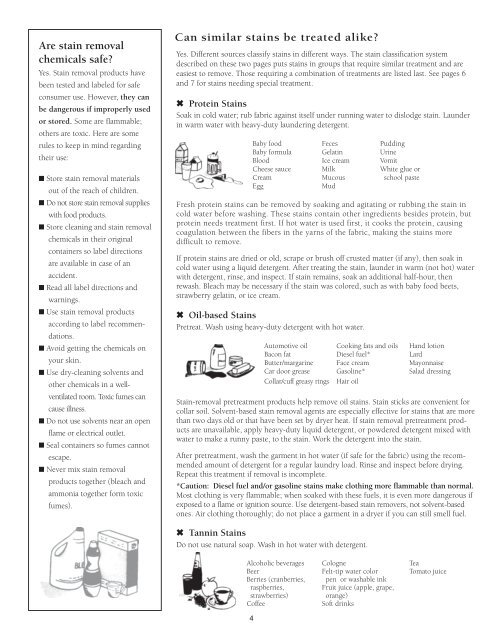n Easy Stain Removal - Orange County Extension Education Center
n Easy Stain Removal - Orange County Extension Education Center
n Easy Stain Removal - Orange County Extension Education Center
Create successful ePaper yourself
Turn your PDF publications into a flip-book with our unique Google optimized e-Paper software.
Are stain removal<br />
chemicals safe?<br />
Yes. <strong>Stain</strong> removal products have<br />
been tested and labeled for safe<br />
consumer use. However, they can<br />
be dangerous if improperly used<br />
or stored. Some are flammable;<br />
others are toxic. Here are some<br />
rules to keep in mind regarding<br />
their use:<br />
■ Store stain removal materials<br />
out of the reach of children.<br />
■ Do not store stain removal supplies<br />
with food products.<br />
■ Store cleaning and stain removal<br />
chemicals in their original<br />
containers so label directions<br />
are available in case of an<br />
accident.<br />
■ Read all label directions and<br />
warnings.<br />
■ Use stain removal products<br />
according to label recommendations.<br />
■ Avoid getting the chemicals on<br />
your skin.<br />
■ Use dry-cleaning solvents and<br />
other chemicals in a wellventilated<br />
room. Toxic fumes can<br />
cause illness.<br />
■␣ Do not use solvents near an open<br />
flame or electrical outlet.<br />
■ Seal containers so fumes cannot<br />
escape.<br />
■ Never mix stain removal<br />
products together (bleach and<br />
ammonia together form toxic<br />
fumes).<br />
Can similar stains be treated alike?<br />
Yes. Different sources classify stains in different ways. The stain classification system<br />
described on these two pages puts stains in groups that require similar treatment and are<br />
easiest to remove. Those requiring a combination of treatments are listed last. See pages 6<br />
and 7 for stains needing special treatment.<br />
✖ Protein <strong>Stain</strong>s<br />
Soak in cold water; rub fabric against itself under running water to dislodge stain. Launder<br />
in warm water with heavy-duty laundering detergent.<br />
Baby food Feces Pudding<br />
Baby formula Gelatin Urine<br />
Blood Ice cream Vomit<br />
Cheese sauce Milk White glue or<br />
Cream Mucous school paste<br />
Egg Mud<br />
Fresh protein stains can be removed by soaking and agitating or rubbing the stain in<br />
cold water before washing. These stains contain other ingredients besides protein, but<br />
protein needs treatment first. If hot water is used first, it cooks the protein, causing<br />
coagulation between the fibers in the yarns of the fabric, making the stains more<br />
difficult to remove.<br />
If protein stains are dried or old, scrape or brush off crusted matter (if any), then soak in<br />
cold water using a liquid detergent. After treating the stain, launder in warm (not hot) water<br />
with detergent, rinse, and inspect. If stain remains, soak an additional half-hour, then<br />
rewash. Bleach may be necessary if the stain was colored, such as with baby food beets,<br />
strawberry gelatin, or ice cream.<br />
✖ Oil-based <strong>Stain</strong>s<br />
Pretreat. Wash using heavy-duty detergent with hot water.<br />
✖ Tannin <strong>Stain</strong>s<br />
Do not use natural soap. Wash in hot water with detergent.<br />
Alcoholic beverages Cologne Tea<br />
Beer Felt-tip water color Tomato juice<br />
Berries (cranberries, pen or washable ink<br />
raspberries, Fruit juice (apple, grape,<br />
strawberries) orange)<br />
Coffee Soft drinks<br />
4<br />
Automotive oil Cooking fats and oils Hand lotion<br />
Bacon fat Diesel fuel* Lard<br />
Butter/margarine Face cream Mayonnaise<br />
Car door grease Gasoline* Salad dressing<br />
Collar/cuff greasy rings Hair oil<br />
<strong>Stain</strong>-removal pretreatment products help remove oil stains. <strong>Stain</strong> sticks are convenient for<br />
collar soil. Solvent-based stain removal agents are especially effective for stains that are more<br />
than two days old or that have been set by dryer heat. If stain removal pretreatment products<br />
are unavailable, apply heavy-duty liquid detergent, or powdered detergent mixed with<br />
water to make a runny paste, to the stain. Work the detergent into the stain.<br />
After pretreatment, wash the garment in hot water (if safe for the fabric) using the recommended<br />
amount of detergent for a regular laundry load. Rinse and inspect before drying.<br />
Repeat this treatment if removal is incomplete.<br />
*Caution: Diesel fuel and/or gasoline stains make clothing more flammable than normal.<br />
Most clothing is very flammable; when soaked with these fuels, it is even more dangerous if<br />
exposed to a flame or ignition source. Use detergent-based stain removers, not solvent-based<br />
ones. Air clothing thoroughly; do not place a garment in a dryer if you can still smell fuel.
















